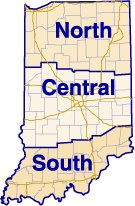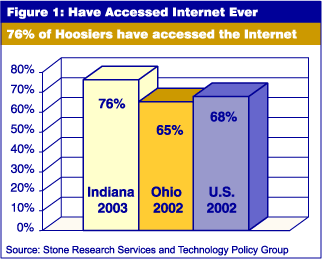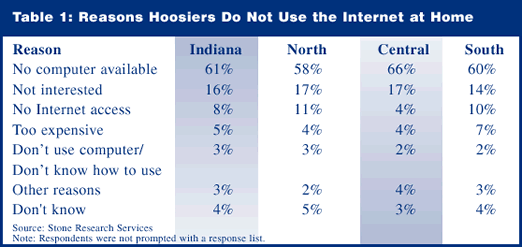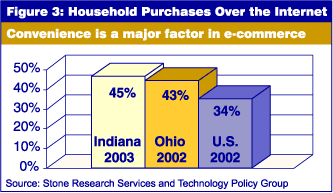If the Future is Here, Where is Indiana?
Michael Dunn, dean of the IU School of Informatics, has astutely observed, "The future is here...it's just distributed unevenly." This is true for economic development—and for technology adoption.
Indiana Interconnect, a study being done by the Indiana Economic Development Council, with assistance from the Indiana Department of Commerce, is assessing Indiana's readiness to compete in a digital economy. As part of that study, Stone Research Services conducted surveys of Indiana businesses and citizens (see inset). The survey instruments were based on the guidelines recommended by the Computer Systems Policy Project (www.cspp.org), a coalition of CEOs from U.S. hardware and systems companies.
 |
Survey SpecsSurveys were conducted over the telephone, using a random selection of telephone numbers prepared by Survey Sampling, Inc. The sample size of 384 interviews per Indiana region (see map) provided a margin of error of plus or minus five percentage points at the 95 percent confidence level. All telephone households within a region had an equal probability of selection for the study. Survey respondents were chosen only from household members age 18 and over. Age and gender bias were neutralized by requesting responses from the household member (18 years of age or older) who most recently had a birthday. |
This article reviews results from surveys of the general public and compares them with responses obtained by the Technology Policy Group in a study conducted for the State of Ohio. The surveys explore the demand side of technology deployment and adoption. Customer demand, or "take rate," is a key factor when service providers make broadband deployment decisions.
So, how do Indiana citizens compare to others on the questions posed?
Do You Have Access to a Computer and the Internet?
The number of Hoosiers who have ever accessed the Internet compares favorably
with the rest of the U.S. (see Figure 1). More granular analysis shows that
81 percent of central Indiana residents report some Internet access, which
is significantly ahead of the national average and also ahead of the northern
(74 percent) and southern (69 percent) regions of the state.

Most adult Hoosiers interviewed (52 percent) access the Internet at least several times a week. Such frequent use is especially prevalent among those in the central region (60 percent) and less in the northern (47 percent) and southern (40 percent) regions. Indiana citizen access to the Internet from home is, however, behind the national average (see Figure 2).

As indicated by the number of households with computers, the central region has adopted technology more aggressively (73 percent) than the north (63 percent) and south (57 percent), as have more youthful and affluent households.
The survey results suggest the need for a program to put more computers in homes. Not having a computer at home is the barrier cited most frequently by respondents in the state, particularly in central Indiana (see Table 1). For citizens in the north and south, lack of Internet access is more of a restraint than it is in the central region. Both constraints contribute to Indiana trailing the U.S. average in Internet access from home.
Thirty-eight percent of survey respondents in central Indiana report that their children under the age of 18 do not have Internet access at school, compared to only 25 percent of those from the northern and southern regions.

How Do You Access the Internet from Home?
The most common method of Internet access from home is over dial-up telephone lines, averaging 78 percent statewide. One in 10 households use a second phone line for Internet access. DSL service is used at about half the rate (6 percent) as cable (12 percent), with a slightly stronger cable presence in the central and southern regions.
Considerable fragmentation exists in the Internet Service Provider (ISP) marketplace. AOL dominates with a 26 percent market share. The closest statewide competitor is MSN with 7 percent of the market share. About 115 additional ISPs were named by respondents as their provider.
Even with the heavy dependence on dial-up service, less than 20 percent of Hoosiers express dissatisfaction with the speed of their Internet access. Perhaps even more surprising is the level of satisfaction with ISP responsiveness. Service is rated as "excellent" or "good" by 77 percent, in spite of at least monthly service interruptions experienced by 56 percent of users. Weekly service interruptions are reported by 25 percent.
The general level of satisfaction with available service might indicate lower standards, less familiarity with advanced services or usage that is more casual and social in nature. For example, only 18 percent of Hoosiers use the Internet for course work, even though the Indiana College Network offers nearly 1,500 courses and more than 100 certificate and degree programs online each year.
Why Do You Use the Internet?
Hoosiers tend to use the Internet for socialization, general surfing and purchases. These activities do not require significant bandwidth to be enjoyed. As use tends more toward work-related activities and distance learning, the demand for higher speed access will likely increase.
Indiana is ahead of the 2002 national average for household e-commerce (see Figure 3), with 22 percent of those now shopping online anticipating increased use. This is especially marked among those in higher income brackets.

Convenience (34 percent) and the ability to shop from home (16 percent) are the top reasons cited for shopping over the Internet. Lower prices were mentioned by only 6 percent of Internet shoppers.
Clothing (31 percent), books (24 percent) and entertainment media (17 percent) top the list of merchandise most frequently purchased over the Internet.
What Would You Change?
Nearly all households (91 percent) express some level of concern about improper usage of personal information gathered over the Internet. Respondents are split 50/50 between high and low levels of concern. In fact, the major constraint against shopping over the Internet (36 percent) is concern about the security of financial information.
Such concerns might explain Hoosier reluctance to use online government services, even though Indiana's services rank among the top 10 of U.S. state governments. Although 60 percent of Internet users have visited local or state government web sites for information and 64 percent declared their willingness to obtain online government services, only 27 percent actually have.
Conclusions
The usage patterns indicated by survey responses suggest a willingness to participate in the digital economy once the case for its benefits are effectively made. Indiana citizens are not very demanding with respect to technology. For example, their computer equipment is somewhat older than the national average.
They also exhibit modest Internet performance expectations with respect to both access speed and service reliability. This represents a marketing opportunity for those who provide advanced telecommunications, online content and applications services.
Home-based Internet technology adoption in Indiana (outside the central region) is slightly less than the national average, although Hoosiers have tried the Internet at a higher rate. Availability of computer equipment at home (followed by Internet access) appears to be the significant barrier, rather than lack of education or technical knowledge.
Once the computer is purchased and the online connection from home is made, however, Hoosiers include Internet use as part of their daily routine. Once engaged, they participate in e-commerce activities at a higher rate than the national average. Once Hoosiers recognize the future, they embrace it.
See Sidebar: Defining the Future
Jennifer Kurtz
eCommerce Director, Indiana Department of Commerce
